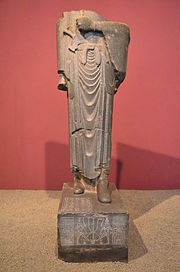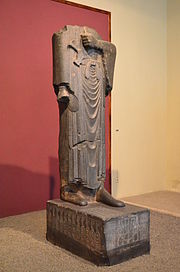Statue of Darius I.
The statue of Darius was found during excavations in the palace of Darius I in Susa in 1972 and has been in the Iranian National Museum in Tehran since 1973 . It is one of the few sculptural works by an Achaemenian ruler. The statue was made in Egypt and is decorated with Egyptian hieroglyphics and cuneiform script . The cuneiform text is written in three languages: Old Persian , Elamite and Babylonian . From the inscriptions show that the statue Darius I represent. It is made of greywacke and is still 2.46 m high today. It was once about 3.5 m high. The upper part of the figure is no longer preserved today.
Location
The statue was found on the west side of the Darius Gate and flanked the south side of the entrance there. On the north side there was probably a second statue, of which no remains were found. The entire gate system formed the eastern entrance to the palace complex. The statue looked at the palace with it.
description
The ruler wears a Persian robe, as is also known from contemporary reliefs . He wears a belt around his stomach with a dagger in his sheath. The scabbard shows rows of winged bulls. At the front of the belt there is a knot on which the name of Darius is written in Egyptian hieroglyphics. The left arm is bent over the stomach and may have once held a lotus flower . Only the stem of the flower is preserved. The right arm hangs on the right side of the body. It is unknown what the fist once held in its hand. Dareios wears thin bangles on his wrists.
The figure stands on a pedestal on which the 24 provinces of the Persian Empire are listed. The list is again written in Egyptian hieroglyphics. The provinces are depicted as kneeling men wearing their national costume. Your arms are raised. Below these figures there is a semicircle with the name of the province in hieroglyphics.
The hieroglyphic text indicates that the statue was once placed in Pithom . It is not certain when she was transferred to Susa, probably shortly after the death of Darius I.
Dating
Using the hieroglyphic spelling of Darius' name, the statue can be dated to the last third of his reign, around 495 to 486 BC. BC Grauwacke was broken in Wadi Hammamat in Egypt . In fact, there are inscriptions there that date back to 496 and 492 BC. BC expeditions attest. In one of these, the stone for this statue will have been broken. These expeditions were led by the head of all works in Egypt, Khnumibre .
literature
- David Stronach: Recherches dans le secteur Est du tépé de l'Apadana 1973-1974. La statue de Darius le Grand découverte à Suse (= Cahiers de la Délégation française en Iran. [DIFA] vol. 4). 1974, pp. 61-72.
- Heinz Luschey : Archaeological remarks on the Darius statue by Susa. In: Files of the 7th International Congress for Iranian Art and Archeology, Munich 7.-10. September 1976. Reimer, Berlin 1979, ISBN 3-496-00103-8 , pp. 207-217.
- Ursula Kaplony-Heckel : The newly discovered statue of Darius I in Susa. In: Otto Kaiser (Hrsg.): Texts from the environment of the Old Testament . Old series, vol. 1: Legal and economic documents - historical-chronological texts. Delivery 6: Historical-chronological texts. Gütersloher Verlagshaus Gerd Mohn, Gütersloh 1985, ISBN 3-579-00065-9 , pp. 609-613.
- Peter Calmeyer : Egyptian style and imperial Achaemenid content on the base of the Darius statue from Susa / Heliopolis (= Achaemenid history. Vol. 6: Asia Minor and Egypt. Old cultures in a new empire. Proceedings of the Groningen 1988 Achaemenid history workshop. ) . Nederlands instituut voor het nabije oosten, Leiden 1991, ISBN 90-6258-406-3 , pp. 285-303.
- Jean Yoyotte: The Egyptian Statue of Darius. In: Jean Perrot (Ed.): The Palace of Darius at Susa. The great royal residence of Achaemenid Persia. Tauris, London 2013, ISBN 978-1-84885-621-9 , pp. 238-271.

